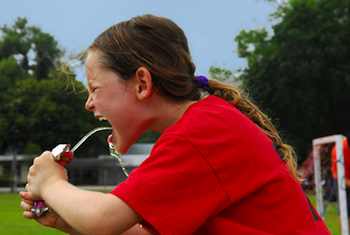- MENU
- HOME
- SEARCH
- WORLD
- MAIN
- AFRICA
- ASIA
- BALKANS
- EUROPE
- LATIN AMERICA
- MIDDLE EAST
- United Kingdom
- United States
- Argentina
- Australia
- Austria
- Benelux
- Brazil
- Canada
- China
- France
- Germany
- Greece
- Hungary
- India
- Indonesia
- Ireland
- Israel
- Italy
- Japan
- Korea
- Mexico
- New Zealand
- Pakistan
- Philippines
- Poland
- Russia
- South Africa
- Spain
- Taiwan
- Turkey
- USA
- BUSINESS
- WEALTH
- STOCKS
- TECH
- HEALTH
- LIFESTYLE
- ENTERTAINMENT
- SPORTS
- RSS
- iHaveNet.com: Health
Sue Hubbard, M.D.

With summer heat at its peak across the country and kids heading back to school athletics, band practice, drill team and the like, this is a good time to discuss heat-related illnesses and their prevention.
It's always at this time of year that I begin worrying about heat exhaustion and heat stroke and find myself re-emphasizing the importance of maintaining hydration, even before you start back to outside activities.
Among high school athletes, exertional heat stroke is the third leading cause of death and is often related to lack of acclimation to the heat and dehydration. You can't just head out to run three miles in the heat, work out in pads, or march in the band on a hot field without preparing ahead of time.
Heat exhaustion occurs when the core body temperature is elevated between 100.4 and 104 degrees. This is different than having a fever secondary to illness. Symptoms are typically non-specific but include muscle cramps, fatigue, thirst, nausea, vomiting and headaches. The skin is usually cool and moist from sweating and is indicative that the body's cooling mechanism is working. The pulse rate is rapid and weak and breathing is fast and shallow. Coaches, athletes and others should all be aware of these symptoms. This is the body saying, "I'm overheated" and don't keep going! (You wouldn't drive your car when it overheated; you'd pull over and at least add water to the radiator.)
The mainstay of treatment is to prevent progression to heat stroke by moving to a cooler place, in the shade, in a building with air conditioning, etc. Remove as much clothing as possible (uniforms, pads, helmets, etc.) to help heat dissipation. Water-misting fans may be helpful. Begin rehydration with appropriate oral electrolyte solutions and water. When treated quickly and appropriately, symptoms usually resolve in 20-30 minutes. The child should not return to activities that day, and should avoid heat stress for several days.
Heat stroke is a MEDICAL EMERGENCY and requires transportation to the emergency room for aggressive treatment. In this case, the previous symptoms have been missed and the core body temperature rises to 104 degrees or greater. The skin is flushed, hot and dry from lack of sweating. The athlete is confused, or even unconscious. The heart rate is fast and there is hyperventilation. The blood pools away from vital organs and can result in encephalopathy, liver, kidney and multiple organ failure.
While awaiting transportation to the ER, the athlete should be moved to a shaded area, clothing removed and ice packs may be applied to surface areas overlying major vessels, (i.e., the neck, beneath the arm pits, and the groin). Cooling and misting fans may also be used.
Continue to educate your children about the need for hydrating the evening before athletic events, and for continuous hydration while exercising in the heat. They should know to drink fluids even when not thirsty, as once you become thirsty you're already behind in your fluid intake. With good education and recognition of early signs of overheating, heat-related illnesses are preventable.
Dr. Sue Hubbard is a nationally known pediatrician and co-host of "The Kid's Doctor" radio show.
Available at Amazon.com:
Copyright © The Kids Doctor. All rights reserved.
AGING | ALTERNATIVE | AILMENTS | DRUGS | FITNESS | GENETICS | CHILDREN'S | MEN'S | WOMEN'S
Health - Keep Your Athletes Hydrated On and Off the Field